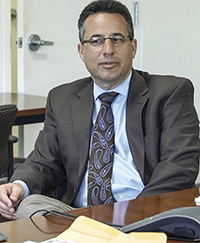
Beyond Episodic Compliance
How three school districts are using accreditation to leverage continuous improvement in different ways
BY MARK A. ELGART/School Administrator, August 2020

|
Eugene Schmidt (left), superintendent in Farmington, N.M., uses feedback from accreditation to ensure his district remains on the intended track. PHOTO COURTESY OF FARMINGTON, N.M., SCHOOL DISTRICT
|
As accreditation has evolved in recent years beyond episodic compliance, district leaders now commonly use feedback from the process to better understand how well they and their schools are performing and to address blind spots. In Farmington and other school districts, leaders have recognized the power of the accreditation process to create ongoing systems to monitor, assess and improve teaching and learning beyond the accreditation cycle. Leaders like Schmidt also are leveraging key components of accreditation — including systematic classroom observations and data analysis — to introduce and reinforce continuous improvement practices of their own.
Farmington educators have followed an instructional model steeped heavily in the classroom practices of Charlotte Danielson and Robert Marzano for more than a decade. The model has become so entrenched within the district that it is known as “The Farmington Way.”
Although Farmington’s approach preceded Schmidt’s 2015 arrival as superintendent, he recognized the importance of a “recommitment to the process,” as he put it. Affirming the district’s instructional model was particularly important, he adds, given ongoing staff turnover. “The Farmington Way was a concept introduced more than 10 years ago,” he says. “Over time, in a district of 1,900 employees, people can forget.”
Creating a Playbook
The district’s systems accreditation review in 2018 focused heavily on confirming that the expectations embedded in the Farmington Way were actively driving education throughout the district. The external review team “gave us a chance to reaffirm that they saw those things in action,” Schmidt says. “They ensured that practices we identify as high-leverage are embedded throughout the district.”
Feedback from the accreditation process identified areas of improvement for the district, including improved communication strategies and community outreach. Data analysis helped school leaders recognize the need to focus supports on students making progress but below proficiency. But more importantly, accreditation provided the impetus to create internal systems and routines that support continuous improvement efforts at all levels.
Following up on the focused team visits, a rubric known as the “playbook” outlines each school’s improvement systems and structures — “not for compliance, but for monitoring and identifying the supports schools need and how those transition to the work we do at the district level,” says Deputy Superintendent Phil Valdez.
Short-cycle assessments inform weekly data team meetings in schools, as well as class data walls and ongoing communication with families. Each school follows what Schmidt calls “in your face” 30-, 60- and 90-day planning cycles to sustain the momentum for change. Building leaders also receive more structured opportunities for leadership development and collaboration.
The district has seen improved student achievement, including increased proficiency levels and graduation rates, and received national recognition for its efforts. In acknowledgment of efforts to close achievement gaps, a Farmington elementary school was named the state’s only National Blue Ribbon School in 2019, following recognition of another district school as a National Title I Distinguished School several years earlier.
“Instructionally, we are different than we were four years ago,” Schmidt says. “We now understand that continuous improvement really means being reflective every day.”
 |
| Pamela Swanson, superintendent in Westminster, Colo., used the accrediting process to advance competency-based education. PHOTO COURTESY OF WESTMINSTER, COLO., PUBLIC SCHOOLS |
A Common Language
Leaders at the Norris School District in Nebraska were aware of “tremendously wonderful innovative ideas developed in different buildings and by different teams,” says John Skretta, who was superintendent of the 2,100-student district until the summer of 2019. However, even in a small rural district in which all three schools are located on the same campus, those innovative ideas proved difficult to replicate, and ongoing improvement efforts were challenged by the lack of consistent systems and structures.
“We continually collect and analyze data, but we’re not sure that the application of data is happening instructionally, because we don’t have a common language,” says Skretta, now the administrator for Nebraska’s Educational Service Unit 6 in Milford.
To improve coherence, district leaders shifted from individually accrediting each school to a systemwide process for the first time in 2013. Self-assessment was a critical part of the first Cognia™ Systems Accreditation, requiring leaders to look at the district in a new way. Says Skretta: “We had to really reflect and ask ourselves, are we truly integrated as a system in things like our professional development, our efforts for curriculum alignment, and the use of instructional strategies?”
Findings from Cognia’s external review provided impetus for change. In particular, outside observers helped reveal the varied guidance teachers were receiving — “from almost no feedback to targeted and specific feedback, from one-to-one where a teacher communicates only with an administrator to meetings where a teacher communicates with a whole faculty/student group,” according to the district’s external engagement review report.
Responding to the results, the district took concrete steps to improve coherence, including introducing its first-ever formal strategic planning process and developing a common language for instruction. Norris also systematized professional development and established baseline expectations for professional learning plans as part of teacher evaluation.
“The accreditation process forces organizational coherence and the ability to articulate that story. … I think that’s really beneficial,” Skretta says.
Rebels with a Cause
In suburban Denver, one pioneering school district has focused extensively on competency-based education, or CBE, over the past decade, replacing traditional grade levels with self-developed performance-based levels. “We’re rebels with a cause,” says Pamela Swanson, superintendent of the Westminster Public Schools.
But even as the district was developing a reputation as a national leader in CBE, it became the first district in the Denver region to face the threat of state intervention. After five years of low but gradually improving student test scores, the 9,300-student district, where more than three in four students meet the poverty standard, saw a drop in performance following Colorado’s introduction of the Partnership for Assessment of Readiness for College and Careers, or PARCC, in 2016. This prompted the state to give Westminster one year to avoid takeover or a forced merger with another district.
 |
Cognia’s CEO, Mark Elgart, believes objective data from an outside review identifies the root causes of schoolwide underperformance. PHOTO BY KRIS RICHARD/COGNIA 2015
|
Leaders looked at districtwide accreditation as an opportunity to identify where the district’s implementation of competency-based education was falling short. In spring 2016, independent reviewers conducted more than 500 interviews and visited 215 classrooms. The process identified three root causes for ongoing performance problems: inconsistent use of the competency-based model, a lack of accountability, and a need for culture building at the secondary level, which began implementing the model later than the earlier grades.
“It was an outside check that validated our thinking,” says Jeni Gotto, the Westminster district’s executive director of teaching and learning. “That gave us the impetus to push forward.”
The following year, Cognia shifted roles from accreditor to the school district’s external continuous improvement partner as part of an agreement with the state. In that role, Cognia experts conducting diagnostic reviews helped district leaders pinpoint additional areas where implementation was lagging, standardize ongoing observations, and develop more focused action planning that shortened continuous improvement cycles at the school level.
Westminster saw the number of its schools in the top tier of the state rating system double in 2017-18, and the district became the first in Colorado to receive dual accreditation from Cognia and the state’s own accountability system. For their efforts, both the school board and its superintendent have received statewide honors, and the district was officially taken off the state accountability clock in 2018.
“If people can understand when you’re moving through a change why you’re doing it, they can back into it a little better,” Swanson says.
Facing Challenges
While their school districts and situations are very different, all three leaders shared common traits. Whether it was the Farmington Way, pockets of innovation or competency-based education, each had a willingness to challenge assumptions about the points of pride within their districts. Each had a desire to bring objective data to bear on identifying root causes of underperformance.
Most importantly, each recognized that improvement, like accreditation, is no longer a periodic exercise but a process that must be woven into everything a district and its schools do to drive meaningful change.
MARK ELGART is president and chief executive officer of Cognia in Alpharetta, Ga. Twitter:
@MarkElgart